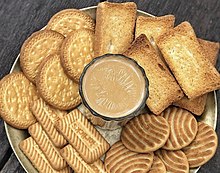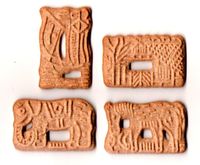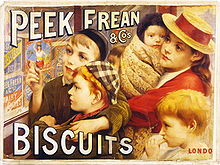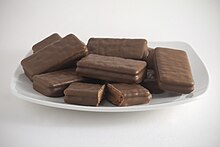Biscuit
A biscuit, in many English-speaking countries, including Britain, Ireland, Australia, New Zealand, India, and South Africa but not Canada or the US, is a flour-based baked and shaped food item.
[7] The British meaning is at the root of the name of the United States' most prominent maker of cookies and crackers, the National Biscuit Company, now called Nabisco.
[citation needed] Another cognate Dutch form is beschuit, which is a circular and brittle grain product usually covered by savoury or sweet toppings and eaten at breakfast.
Further confusion has been added by the adoption of the word biscuit for a small leavened bread popular in the United States.
[13] A biscuit is "any of various hard or crisp dry baked product" similar to the American English terms cracker or cookie,[12] or "a small quick bread made from dough that has been rolled out and cut or dropped from a spoon".
[12] In a number of other European languages, terms derived from the Latin bis coctus refer instead to yet another baked product, similar to the sponge cake; e.g. Spanish bizcocho, German Biskuit, Russian бисквит (biskvit), and Polish biszkopt.
The need for nutritious, easy-to-store, easy-to-carry, and long-lasting foods on long journeys, in particular at sea, was initially solved by taking livestock along with a butcher/cook.
The introduction of the baking of processed cereals, including the creation of flour, provided a more reliable source of food.
[14] Roman cookbook Apicius describes: "a thick paste of fine wheat flour was boiled and spread out on a plate.
Because it is so hard and dry, if properly stored and transported, navies' hardtack will survive rough handling and high temperature.
The collection Sayings of the Desert Fathers mentions that Anthony the Great (who lived in the 4th century AD) ate biscuits and the text implies that it was a popular food among monks of the time and region.
[16] At the time of the Spanish Armada in 1588, the daily allowance on board a Royal Navy ship was one pound of biscuit plus one gallon of beer.
[17] Biscuits remained an important part of the Royal Navy sailor's diet until the introduction of canned foods.
By the 7th century AD, cooks of the Persian empire had learnt from their forebears the techniques of lightening and enriching bread-based mixtures with eggs, butter, and cream, and sweetening them with fruit and honey.
[23] The first documented trade of gingerbread biscuits dates to the 16th century, where they were sold in monastery pharmacies and town square farmers markets.
Manufacturers such as Huntley & Palmers in Reading, Carr's of Carlisle and McVitie's in Edinburgh transformed from small family-run businesses into state-of-the-art operations.British biscuit companies vied to dominate the market with new products and eye-catching packaging.
[26] Competition and innovation among British firms saw 49 patent applications for biscuit-making equipment, tins, dough-cutting machines and ornamental moulds between 1897 and 1900.
[25] Along with local farm produce of meat and cheese, many regions of the world have their own distinct style of biscuit due to the historic prominence of this form of food.
Biscuits and loaves were introduced in Bengal during the British colonial period and became popular within the Sylheti Muslim community.
[28]: 2 Cracker doughs often have some of the following features: they are leavened, have a water content between 15–25%, are laminated and rise during the first part of baking.
The category covers many regional specialties, including the British custard cream and digestives, the Dutch speculaas, the Indian glucose biscuit and the Scottish shortbread.
The structure is derived from a high humidity during early stages of baking[28]: 6–7 The widest category, cookies have very soft doughs.
Cookies have high sugar and fat contents, and are cooked longer than other biscuits at relatively low temperatures.
[33] Chocolate digestives, rich tea, and Hobnobs were ranked the UK's top three favourite dunking biscuits in 2009.











